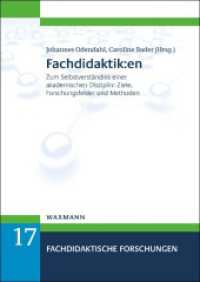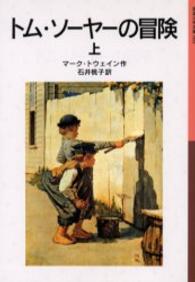- ホーム
- > 洋書
- > 英文書
- > Architecture
Full Description
A groundbreaking book by one of the world's leading historians of Chinese architecture Translated by Alexandra Harrer Fu Xinian is considered by many to be the world's leading historian of Chinese architecture. He is an expert on every type of Chinese architecture from every period through the nineteenth century, and his work is at the cutting edge of the field. Traditional Chinese Architecture gathers together, for the first time in English, twelve seminal essays by Fu Xinian. This wide-ranging book pays special attention to the technical aspects of the building tradition since the first millennium BC, and Fu Xinian's signature drawings abundantly illustrate its nuances. The essays delve into the modular basis for individual structures, complexes, and cities; lateral and longitudinal building frames; the unity of sculpture and building to create viewing angles; the influence of Chinese construction on Japanese architecture; and the reliability of images to inform us about architecture.
Organized chronologically, the book also examines such topics as the representation of architecture on vessels in the Warring States period, early Buddhist architecture, and the evolution of imperial architecture from the Tang to Ming dynasty. A biography of Fu Xinian and a detailed Chinese-English glossary are included. Bringing together some of the most groundbreaking scholarship in Chinese architectural history, Traditional Chinese Architecture showcases an uncontested master of the discipline.
Contents
List of Illustrations vii Preface xv Editor's Note xvii Chronology of Chinese Dynasties xxi Map of China xxiii Biography of Fu Xinian xxv 1 Representations of Architecture on Vessels of the Warring States Period 1 2 Reconstruction of Northern Dynasties Buildings Based on Relief Sculpture and Murals in Cave-Temples at Maijishan 31 3 Early Buddhist Architecture in China 79 4 The Development of Timber-Frame Architecture during the Two Jins and the Northern and Southern Dynasties 97 5 Architectural Features of the Northern and Southern Dynasties and the Sui and Tang Periods in China as Reflected in Japanese Architecture of the Asuka and Nara Periods 140 6 Hanyuan Hall at Daminggong in Tang Chang'an 167 7 The Module in Tang Architecture 209 8 Imperial Architecture of Tang through Ming and Its Relation to Other Architecture 226 9 The Problem of Pillar Displacement with Respect to the Characteristics of Song Construction 253 10 Song Architecture in South China and Its Relation to Japanese Great Buddha-Style Architecture of the Kamakura Period 273 11 Northern Song Architecture in the Painting A Thousand Li of Rivers and Mountains by Wang Ximeng 296 12 Typical Design Features of Ming Palaces and Altars in Beijing 315 Glossary 349 Index 375








